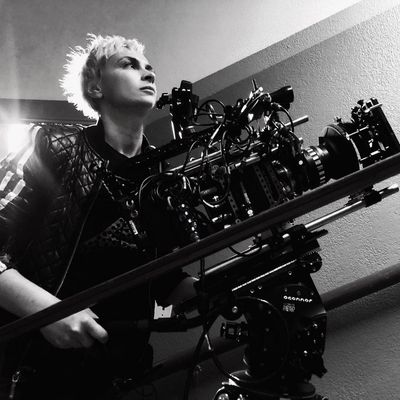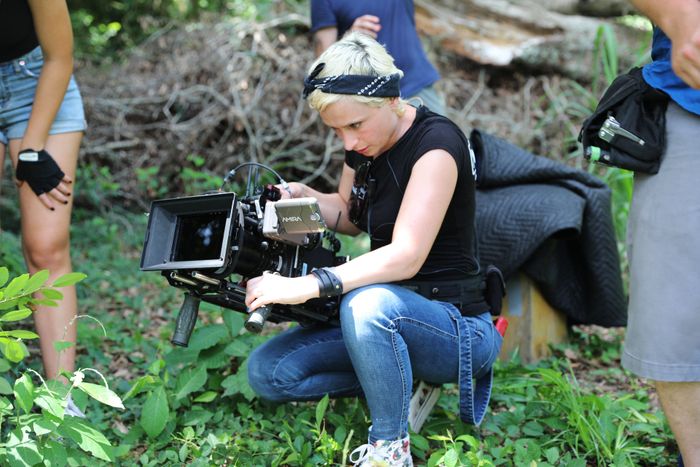
Halyna Hutchins, the cinematographer killed Thursday in a tragic accident involving a prop gun fired by Alec Baldwin on a movie set in New Mexico, was an emerging talent in Hollywood: a meticulous perfectionist known for her on-the-fly creativity and boundless energy who was making inroads as a woman in a male-dominated field. Widely mourned within the cinematography community, Hutchins’s death takes on added weight at a moment when Hollywood’s below-the-line rank and file in the International Alliance of Theatrical Stage Employees came close to a strike that would have paralyzed the TV and movie industries in a protest against producers who they say work them too hard and don’t care enough about their safety.
Selected as one of American Cinematographer’s Rising Stars of 2019, the Ukrainian native had parlayed work in short films and commercials into director-of-photography credits on a string of independent films including The Mad Hatter, Blindfire, and Archenemy. And those who worked with Hutchins — a 42-year-old graduate of the American Film Institute Conservatory who also held a degree in international journalism from Kyiv University — praised her commitment to excellence and freewheeling creativity behind the camera. “She always had so many ideas about how to make something look cooler, how to make it look better, how to make it more interesting,” says Eli Lipnik, producer of The Mad Hatter. “She was so picky and particular about getting the shots she wanted. So many of them on our film were so beautiful. The director, VFX supervisor, and I would watch dailies and say, ‘Wow, that was really shot nicely. That angle was really amazing. Those colors!’ She was really talented. She was a rising star.”
Hutchins’s death is being investigated by police; director Joel Souza was also injured in the incident, which took place on the set of the period Western Rust. The film follows a teenage boy in 19th-century Kansas who goes on the run with his grandfather (Baldwin, also a producer) after being sentenced to death for murder; it was one of Hutchins’s highest-profile projects to date.
Cate Devaney, the director of the highly stylized low-budget horror drama The Mad Hatter, recalls Hutchins as a force of nature: a brave and relentless hurricane of productivity with deep connections and enormous affection in the cinematography world. “She had this pixie-angel quality about her,” Devaney says. “She had this huge aura. She was so striking and beautiful. She’s Ukrainian, though, so don’t cross her. She had all these stories about growing up in the Arctic, cross-country skiing to school. She hated caviar. They didn’t have produce in the Arctic so her mom would make her eat caviar for protein.”
According to Devaney, Hutchins deliberately sidestepped any focus on her gender despite being an outlier in a quadrant of the filmmaking world that is still overwhelmingly dominated by men. “She had a beautiful son, but I know she was worried about people saying, ‘You’re not going to want to do this job because you’re a mother,’” Devaney said. “She was very much aware people would make those assumptions and not offer you jobs, not call you, because they just assume you’re going to want to stay at home and not travel for work.”
“Her work ethic was just endless, tireless,” Devaney adds. “She always wanted to push. ‘Do you think we can just get 10 more minutes?’ She wanted to lead with that quality. The hard work. The proof she had the talent and skill. Being sure that people see those things first rather than put [her] in a box as a wilting flower.”
Hutchins’s death has triggered undisguised paroxysms of grief among actors and filmmakers who worked with the cinematographer, some of whom posted tributes to her on Twitter. Baldwin, for his part, took to the site to indicate that he is cooperating with the police investigation.
Like an increasingly vocal group within the film industry, on Friday Michael Nell, the writer-director of the 2020 crime-drama Blindfire, was processing the sadness he feels from losing a respected and talented collaborator with anger at the seemingly avoidable lapses in safety protocol that led to her death. “Her imagery has her DNA all over it and I hope everyone goes and sees her art and understands the talent we senselessly lost,” Nell tells Vulture in an email. “We lost a real one, an actual artist who stood out in a world of quickly thrown together content driven by business.”
He added, “There’s no need for live ammo or even blanks on set in this day and age … There is no reason to risk lives with gun powder on set outside of financial. There is no excuse I can accept for this loss.”
Fighting back tears during a phone call Friday, Devaney said the devastation being expressed throughout the filmmaking world is twofold. It plays out against a backdrop of acrimonious negotiations between IATSE, the labor organization encompassing 150,000 behind-the-scenes workers on movies and television, and the Alliance of Motion Picture and Television Producers, which the union threatened with a lockout for what workers describe as grueling working conditions requiring them to forgo basic human needs such as bathroom breaks and sleep. On Friday, the Los Angeles Times reported that six camera crew workers on Rust walked off the set just hours before the prop gun incident to protest difficult working conditions.
“She was so great at getting to know people. She worked so much. There are the thousands of people who have met her all around the world. There’s the personal connection,” Devaney said. “And then there is this absolute heartache that is being felt by crew members who just feel their lives aren’t valuable. And they’re told, If you don’t like it, don’t work in film. So this is already going on. And then this happens. It supercharged the feeling — even if you didn’t know her, there was this frustration and anger about how people were being treated.”



